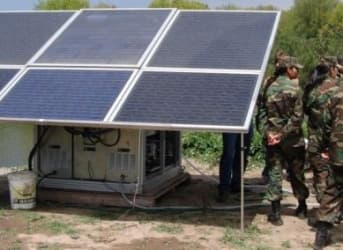Last month, an estimated 1,700 NATO troops undertook a military exercise to test a range of renewable and energy efficiency technologies that will hopefully reduce NATO’s reliance on fossil fuels. With thousands of soldiers killed or injured in attacks on fuel convoys across conflict zones, reducing the military’s vulnerability is critical.
However, it is not just military operations but also humanitarian assistance efforts that stand to gain from greater innovation in renewable deployment and efficiency in complex and dangerous situations.
Delivering fuel to combat zones is both risky and expensive. Attacks on fuel convoys in places like Iraq and Afghanistan are all too common. More than 3,000 U.S. soldiers have been killed or injured in Afghanistan since September 11, 2001 due to attacks on fuel convoys.
Fuel makes up around half of all goods transported by convoy. And there are few alternatives. Airdrops are one option but they are expensive and arguably wasteful. Up to seven gallons of fuel are required for every gallon delivered to a remote base and drops are not always well targeted. Related: Bakken Production Remains Firm In Spite Of Low Oil Prices
These challenges are shared by armed forces across the globe. But programs for energy efficiency and renewable technologies could soon change that.
NATO began its Smart Energy program in 2011 to explore ways to improve the use of solar energy and storage options as well as innovations in micro grid technology to better manage energy use at base and on the move. Small scale wind and solar are the main contenders for power generation on remote bases.
The U.S. Department of Defense created the Office of the Assistant Secretary of Defense for Operational Energy in 2010 to research new approaches to energy security. Programs are exploring efficient generators, advanced batteries, portable solar arrays, and improved insulation to reduce costs and fuel drops. Air conditioning alone costs billions of defense dollars per year, for example. Related: Indiana Jones, Beyoncé, And Saudi Oil Production
Back on U.S. soil, all branches of the military are working towards increasing renewable deployment on bases, moving closer to the Department of Defense’s goal of having 25 percent of its energy needs met by renewable resources by 2025.
These same projects have much to offer military and civilian workers operating in humanitarian crises. Access to reliable power is essential to providing an adequate humanitarian response – in particular medical assistance – and also for rebuilding affected communities.
The benefits of access to fuel for cooking, lighting, heating, and power have been well documented. As in a combat zone, diesel-powered generators and gasoline are expensive and access to the grid unreliable or non-existent. Beyond the household, communities that are remote or have been cut off by a disaster can benefit from a wide array of renewable-powered projects, such as solar-powered water pumps. Moreover, safe access to power can provide a semblance of normalcy for people in an otherwise difficult and even hostile environment. Related: Bearish News For Oil Growing By The Day
Innovative solutions coming out of the military can be adapted to a civilian context. The critical element is the need for the system to be self-contained, easy to set up and operate, portable, and sustainable. Portable water and power solutions developed for a Navy SEAL team on the move, for example, could be applicable to a remote community cut off by a natural catastrophe or refugee camp cut off by conflict.
Of course, humanitarian organizations are developing many of their own solutions but more cross-pollination should be welcomed.
The importance of climate change as a driving factor should not be underestimated. Military commanders have recognized that climate change will bring about more challenging conditions, conflicts, and humanitarian crises. While the military and humanitarian sectors do not always mix, there is no shortage of opportunities for each side to learn from each other in this space and to both contribute to the greater deployment of renewable energy.
By Alexis Arthur for Oilprice.com
More Top Reads From Oilprice.com:
- Alberta’s Government Kicking Oil Industry While It’s Down
- The Economics Of Fracking For The UK
- Bearish News For Oil Growing By The Day


















